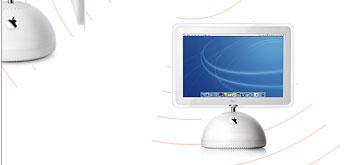Both models of the iMac comes
with state-of-the-art AirPort Extreme wireless networking capability.
AirPort Extreme consists of two components — the AirPort Extreme Card
and the AirPort Extreme Base Station — and it brings the online world
to every room in your home, without that unsightly cable clutter that’s
so often the norm with computers connected to the Internet.
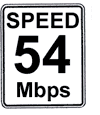 54
Mbps — nearly 5x faster 54
Mbps — nearly 5x faster
AirPort Extreme is a powerhouse performer, with the new 802.11g
technology delivering a wireless data rate of up to 54 megabits per
second (Mbps), nearly five times faster than before.(1) You’ll see how fast this technology really is when you network between AirPort Extreme enabled computers in your home or office. AirPort Extreme is perfect for file sharing, web surfing, sharing a USB printer and multiplayer gaming. The AirPort Extreme Base Station also features a compatibility mode that automatically supports not just the AirPort Extreme Card (at data rates up to 54 Mbps), but all Wi-Fi (802.11b-compliant) products on both Mac and Windows systems (at data rates up to 11 Mbps).
 There’s no longer a need to
set up your computer near a phone. Just pop the new AirPort Extreme
Card into your iMac’s AirPort Extreme slot, and you’re ready for
wireless networking from anywhere in your home or dorm — not just where
your phone jacks happen to be. There’s no longer a need to
set up your computer near a phone. Just pop the new AirPort Extreme
Card into your iMac’s AirPort Extreme slot, and you’re ready for
wireless networking from anywhere in your home or dorm — not just where
your phone jacks happen to be.
AirPort Extreme, like AirPort, uses radio waves to communicate. Unlike
infrared signals, which require an unobstructed line of sight between
the remote unit and the base station, radio waves can pass through
solid objects from up to 150 feet away. Which means that you can keep
your iMac in any room in your house and surf the Internet through walls.
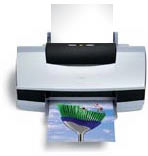 Wireless printer sharing Wireless printer sharing
AirPort Extreme lets everyone in a home or small office share a single
Internet connection — and an Ethernet or USB printer — wirelessly.(2)
The AirPort Extreme Base Station ships with a USB port for printer
sharing. One model adds a 56K V.90 modem and a connector for attaching
an optional, range-extending antenna, for $249.
 Bluetooth
wireless connectivity Bluetooth
wireless connectivity
Like AirPort Extreme, Bluetooth replaces physical cables between products with a wireless connection. Operating within a 30-foot radius, it enables wireless data transfers between a rapidly growing list of Bluetooth-enabled products. Using iSync, for instance, you can use Bluetooth to synchronize your personal information between your iMac, your mobile phone and your handheld.
You can have an internal Bluetooth module installed when you order your
new iMac from the Apple Online Store. Or, if you decide to get
Bluetooth wireless connectivity later on, you can easily plug in an
external D-Link USB Bluetooth Adapter.
- Achieving data rates of 54 Mbps requires that all users
have an AirPort Extreme Base Station and a computer with an AirPort
Extreme Card. If a user of a Wi-Fi certified 802.11b product joins the
network, that user will get up to 11 Mbps and AirPort Extreme users
will get less than 54 Mbps. Actual speed will vary based on range,
connection rate, site conditions, size of network, and other factors.
- Wireless Internet access requires AirPort Card or AirPort
Extreme Card, AirPort Base Station or AirPort Extreme Base Station, or
other wireless access point, and Internet access (fees may apply). Some
ISPs are not currently compatible with AirPort and AirPort Extreme.
Range may vary with site conditions. Wireless printing over USB
requires Mac OS X v10.2.3 or later and a compatible printer.
|
|
Setting up AirPort Extreme
Choose a location for your AirPort Extreme Base Station — on a desk,
bookcase or other flat surface, or mounted on a wall — and set it up
for wireless networking with just three easy steps:
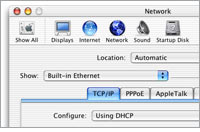
Step 1: Use your iMac to test your Internet connection.
First, verify that you can connect to the Internet via your computer’s
dialup modem or Ethernet port (using your DSL modem, cable modem or
Local Area Network).
Step 2: Plug in the AirPort Extreme Base Station. Plug the
base station’s power adapter into the power adapter port and connect it
to an electrical outlet (the base station automatically turns on when
the power adapter is plugged in and connected to an electrical outlet).
 If you use a standard modem and
analog telephone line (the type of telephone line found in most homes)
to access the Internet, connect one end of the phone cord to the modem
port in the base station and the other end to your telephone jack. If you use a standard modem and
analog telephone line (the type of telephone line found in most homes)
to access the Internet, connect one end of the phone cord to the modem
port in the base station and the other end to your telephone jack.
 If you have an Internet account
that uses a device such as a DSL or cable modem, connect the device to
the Ethernet wide area network (WAN) port on the AirPort Extreme Base
Station the same way it was connected to your computer. If you have an Internet account
that uses a device such as a DSL or cable modem, connect the device to
the Ethernet wide area network (WAN) port on the AirPort Extreme Base
Station the same way it was connected to your computer.
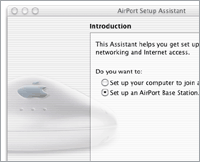
Step 3: Use AirPort Setup Assistant to do the rest for
you. Setup Assistant sets up your network, transfers the active
Internet settings from your computer to the AirPort Extreme Base
Station, and configures your computer to access the AirPort network
created by the base station. (AirPort Setup Assistant is located in the
Utilities folder in the Applications folder on your hard disk.)
|

